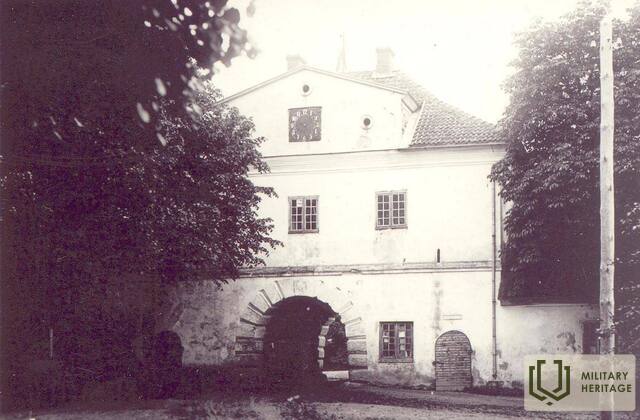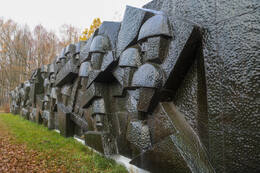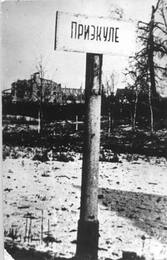The story of 19-year-old Raisa Ahmedeyev about the reconnaissance battle on February 14, 1945 near Priekule
Bashkir-born Red Army soldier Rais Ahmadeev's (19 years old) account of the Soviet army's preparations for the attack on Priekule and the reconnaissance battle in Piekule on 14 February 1945.
“February 1945 dawned. The weather was changeable, as it is often in the Baltics. Cold in the morning, snowing during the day, rain starting in the evening, but freezing again at night.
Our 267th Red Banner Guard Rifle Division, awarded the Order of Suvorov, was located a little more than 1 km southwest of Priekule, where peat digging work had previously been carried out. The front line of our army was established there. From there, the attack on the German forces stationed in Priekule began on February 20, 1945. This place temporarily became our – the riflemen’s – home. Artillery and other army units were located behind us, on a hill in the forest. It was easier to dig dugouts there, to set up bunkers. For us, the infantry, the most advantageous location was right in the peat bog. At that time, I served in the 848th Rifle Regiment.
The German defense line was arranged in a zigzag pattern on the high ground from your school ravine to the railway station in the city. We were in the palm of our hand against the Germans. The hardest part of the day was getting through it, because we were not allowed to raise our heads from the trenches unless we wanted to get a bullet in the head. The Germans were constantly firing shrapnel at our positions, which exploded right above our heads.
The trenches could not be deeper than 1 m, or the depth of a sapper's shovel, because the water accumulated deeper. We carefully placed the earth from the trenches around them, forming a small protective wall. We covered it with snow as much as possible. We covered the ground in the trenches with alder branches. I remember very well that there was a small alder forest near my position. We could dig trenches only at night, and with great difficulty, because not far behind our trenches, enemy shells had set fire to the peat. It was burning. On the one hand, good - you could sneak up to it to warm yourself. On the other hand, very dangerous, because the Germans could shoot a daredevil by the light of the burning peat.
The march for food from a place closer to the road was especially dangerous. We ate only 2 times a day: a very early breakfast, while it was still dark, and a very late lunch, when it was already dark. It often happened that the food carrier came under fire and either coped with the task or was shot. It also happened that the soldier who was carrying the food, fleeing from the fire, stumbled, and the food from the pot spilled onto the ground. Then we were left without food.
When we wanted to eat, we thought a lot about what to do? We figured it out! Shot horses were lying around near our position. We crept up to them, cut off or chopped off a piece with a sapper's shovel. Then we put it on a flexible alder stick and crept to the burning peat, where we could roast it. If we were lucky enough that there was no shooting, we could put snow in a saucepan, melt it, and boil a piece of horse meat. But only boil it, it remained raw inside anyway. But that's okay. When you want to eat, you can eat it like that.
From time to time, our soldiers went on reconnaissance. They were also tasked with capturing a German in order to obtain more information about the German defensive positions. That is why we called such prisoners “tongues”, and the scouts went after the “tongue”. At the same time, German snipers with optical sights and powerful searchlights scanned our positions and shot at anything that even looked like a person moving. From time to time, a hot air balloon could also be seen in the sky, from which the Germans were studying our defensive positions. Our artillerymen often fired at these balloons and their pilots.
Aviation participated in the battles near Liepāja, above the port. We knew this because everywhere there were calls “To Liepāja! For Liepāja!” That was the main direction of our battles – the main goal.
Komsomol meetings were held at night, where, in addition to discussing Komsomol issues, the soldiers were also psychologically prepared for battle. There were no violations of discipline, the soldiers were very disciplined. But this is understandable, because violations of discipline could cost lives.
We received letters from home regularly. There were also shipments from complete strangers – socks, boots, handkerchiefs, tobacco and other useful things for a soldier. We were very happy about these shipments, because they came from there – from home, from behind the front. For them, we were ready to fight as much as necessary to get home as soon as possible.
We lived like this until February 20, 1945. Every day we watched Priekuli and its surroundings and waited for the order to go into battle.”
The Germans had also prepared defensive positions. Only they had more time to complete this task as the front line approached. Perhaps that is why their defensive positions resembled an impregnable fortress.
Almost every house built of stone or brick in the town of Priekule and the countryside was adapted for both hiding and shooting purposes. Most of these houses also had basements, where one could hide from air raids, rest, bandage the wounded, store weapons, ammunition and food. Since there were quite a few such country houses in the relatively flat area of Priekule, access to these fortified points of the German defense system was extremely difficult. If there was a forest, hill, or bushes near the houses, then nothing. But so ... across the open field ...
Near many country houses, the Germans had used an unusual element of the defense system – tanks buried up to the barrel in the ground. From here, optical devices could survey the surroundings quite far away, and from here, it was possible to shoot in any direction, because the tank barrels could be rotated. Thus, tanks hidden in the ground were relatively difficult to notice. They could only be destroyed with aerial bombs or large-caliber weapons, which were in catastrophic shortage of ammunition. Therefore, the machines buried in the ground were a very reliable cover for everything and everyone who was in them. In some places in the Priekule district, you can still see square, partially blocked pits. Some of them were not armored vehicles, but tank positions.
In Priekule, all the city's brick buildings were turned into thoroughly fortified support points of the defense system: the station, the church, the brick kiln, the cast iron foundry (on the site of the former dairy), the grain storage point, the Swedish Gate and the Corfu House. During the last war, a school operated, but as the front line approached, a German hospital was established here. In the area between Raina, Tirgus, Galveno and Ķieģeļu streets, there were several more brick buildings with several floors. Only they were destroyed in air raids already in 1944.
The Lutheran Church is the highest point in Priekule. Even during the war, it was possible to see a fairly wide area of the city from it, so the church was made the main observation and control point of the area. At night, a powerful searchlight was lit in the church tower, which, when moving, could illuminate any place around the city with its beam of light, so that it was extremely difficult to approach the city unnoticed. There was also a sniper point in the church, so that anyone and everything approaching Priekule could be immediately destroyed.
All the main points of the German defense system, both inside and outside the city, were connected by trenches. Soldiers could move along them relatively comfortably and safely. Trenches were extremely important for maneuvering during battles, especially in the relatively flat terrain of the Priekule area. By the time of the battles for the liberation of Priekule and its surroundings, the Germans had created three defensive lines, each about 7 km wide. Each of them had 1-3 trenches that connected the main fortification points - some buildings and structures above or below ground.
Absolutely all the roads of any importance were mined, in places destroyed or blocked with stones and fallen trees. The main approaches to all the defense lines and their fortified support points were also mined, covered with barbed wire screens and ditches. Forest paths were also blocked with fallen trees. The Virga River with its relatively steep banks was a natural element of the German defense system, difficult for heavy military equipment to overcome.
A system of trenches suitable for individual soldiers and small groups of them covered the entire Priekule area like a net. Many of these places are still clearly visible in places not used by people in everyday life – in forests, on the edges of forests and bushes."
leishmalite.lv
Your comments
Related timeline
Related objects
Priekule Memorial Ensemble of Warrior’s Cemetery
The Priekule Memorial Ensemble of Warrior’s Cemetery is on the Liepāja-Priekule-Skoda road and is the largest burial site of Soviet soldiers of World War II in the Baltics. More than 23,000 Soviet soldiers are buried here. Operation Priekule was one of the fiercest battles in Kurzeme Fortress that took place from October 1944 to 21 February 1945. The Battle of Priekule in February 1945 lasted seven days and nights without interruption and had a lot of casualties on both sides. Until Priekule Warrior’s Cemetery was transformed into a memorial, the last monument of the outstanding Latvian sculptor K. Zāle (1888-1942) was located here to commemorate the independence battles in Aloja. Between 1974 and 1984, the 8 ha Priekule Warrior’s Cemetery was transformed into a memorial ensemble dedicated to those who fell in World War II. It was designed by the sculptor P. Zaļkalne, architects A. Zoldners and E. Salguss, and the dendrologist A. Lasis.
The centre of the memorial holds a 12 m tall statue called the ‘Motherland’, and names of the fallen are engraved on granite slabs. Until Latvia regained its independence, the Victory Day was widely celebrated every year on May 9.









Another good story based on a soldier's experience from this area of Latvia.